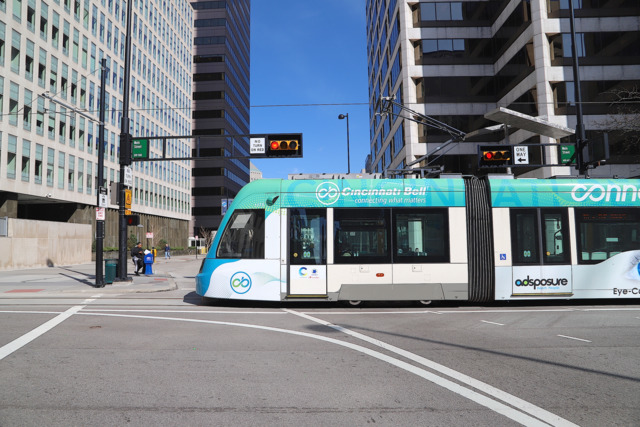For at least the next 60 days, you won't need a dollar bill or a fare app to ride Cincinnati's 3.6-mile rail loop through downtown and Over-the-Rhine.
Cincinnati City Council today overrode a veto by Mayor John Cranley to eliminate fares for the Cincinnati Bell Connector. That vote capped off a lengthy fight that has been raging since June, when Cranley vetoed council's initial legislation during the city's budget process. But it took two more vetoes and plenty of debates in council to get to this point.
Council also batted down Cranley's most recent attempt to keep the streetcar from running without fares — an ordinance that would have used streetcar fares to pay for extra police presence in places like OTR's Grant Park that have seen gun violence during an historic uptick in shootings this year.
But a number of council members questioned the efficacy of that plan, saying it would take more than a few more police officers to solve the problem of neighborhood violence.
“This is not a plan, this is a stunt," council member Greg Landsman said of Cranley's proposal. "I believe when we go into these areas where people are being denied basic human rights to live without fear, we should do it with everything we have… working with all of our partners to bring in support services and jobs that these neighborhoods are screaming out for.”
Cranley said that he never intended the ordinance to be a comprehensive plan for addressing gun violence, but a "down payment" on efforts to solve the issue. He said the streetcar mostly benefits wealthy downtown residents at the expense of the city's working poor, who still have to pay for bus fare.
"If it’s desperate, we should not be giving fares away," Cranley said. "The fact is, bus riders have to pay bus fares. If they have a user fee, why is it fair that streetcar riders, who have been heavily subsidized anyway, don’t? If you don’t want to put it into police visibility, why not put it into the social work you’re suggesting?”
Vice Mayor Christopher Smitherman was the only council member to vote for Cranley's plan. He said that during debates over the streetcar early last decade, taxpayers were promised they wouldn't have to subsidize the streetcar. Now, riders aren't paying anything for it, he said.
But council member Jan-Michele Lemon Kearney had another view. She opposed the streetcar during the public debate before its construction, she said, but now that the tracks are in the ground she wants it to be successful.
"I think that our job now, now that we have it, is to make it a success," she said today. "We learned this summer that it was less expensive to run the streetcar than it is to not run it. We’ve seen it run without anyone on it… that seemed ridiculous to me. We can do better than that.”
Kearney also expressed concern that fare revenues might not bring in enough to cover the cost of collecting the fares. Last year, the city came out about $70,000 ahead on that equation — and that was without a global pandemic that has dropped ridership significantly, she said.
Council member Jeff Pastor, a Republican, called the debate "an equity issue."
""You can throw money and police at every issue," he said. "The reality is, what we're experiencing all over this city is chickens coming home to roost from policies that were racist and classist, including not investing in transit."
Streetcar passenger service was suspended during the beginning days of the COVID-19 pandemic, but continued to run without passengers to keep it operable.
The $1.5 million needed to fund the streetcar's operation will come from the city's general fund. Council must approve further legislation making the fare-free operation permanent.






